03 May 2023
The Battle of Tunis: The Allies' final victory of the North African campaign
In May 1943, the Allies rode triumphantly into the Tunisian capital Tunis. The war in North Africa was finally over. But how did they get here? Learn the story of the Battle of Tunis.
The Battle of Tunis
The North Africa Campaign
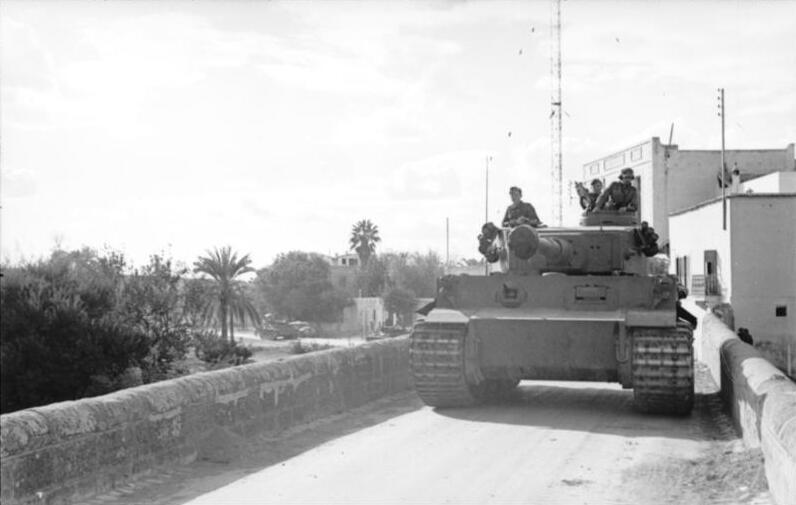
A fearsome German Tiger Tank prowls the streets of a Tunisian village (Wikimedia Commons)
The North African campaign had been raging across the region’s desert sands and oases, towns, cities, and villages, since June 1940.
What began with an Italian invasion of Egypt had escalated into a major World War Two theatre. British and Commonwealth troops scored early victories against the Italian forces arrayed against them, but the tide would soon turn in the Axis’ favour.
German Commander Erwin Rommel and his Afrika Korps had arrived in force in April 1941. From then on, British and Commonwealth ground forces pushed back, despite the Desert Air Force wing of the RAF continuing to score victories in North African skies.
Eventually, Rommel and the Wehrmacht would be stopped dead at the Battles of El Alamein. Bernard Montgomery took control of the British 8th Army, and in November 1942 scored a decisive victory at the Second Battle of El Alamein. The tide had begun to swing in the Allies’ favour.
Rommel was pushed out of Egypt into Libya and eventually Tunisia.
American troops were also deployed to North Africa under Operation Torch in early 1943. Following Allied amphibious landings in Morocco and Algeria on one side, and 8th Army steaming in from Egypt and Libya, the days of the Afrika Korps were numbered.
The Axis forces still fought a determined fighting withdrawal into Tunisia. At Medjez-el-Bab in Tunisia, the British encountered fierce resistance.
Kasserine Pass, an important through road on the way to Tunis, also resulted in a stinging defeat for the American troops tasked with taking it.
With hindsight, it may look like the Axis were just delaying the inevitable but the fighting on the ground was still tough.
Longstop Hill

British Infantry advance at Longstop Hill with Churchill Tank (© National Army Museum)
Capturing high ground and important geographical features is integral to warfare. The build-up to the liberation of Tunis was no different.
Tunisia’s geography features many plunging valleys and craggy hills and ridges. Controlling the heights gives defenders and attackers alike a huge advantage.
One of the key points the Allies had to take on their way to Tunis was an area of high ground called Longstop Hill.
Longstop Hill was really a massif in the Medjerda Valley comprised of two hills called Djebel Ahmera and Dejebel Rhar. They sat along the British 1st Army’s path to the Tunisian capital.
Longstop Hill had been fought over before on the original push into Tunisia in late 1942. As of April 1943, however, it was still in Axis hands.
German panzergrenadiers held the hilltop. They were well dug in, with the hills bristling with machine-gun nests, anti-tank guns, and mortar pits.
A force comprised of Surreys, Buffs, West Kensington and Argyll and Sutherland Highlanders regiments were tasked with the capture of the two parts of Longstop Hill. They were to be supported by the tanks of the North Irish Horse regiment.
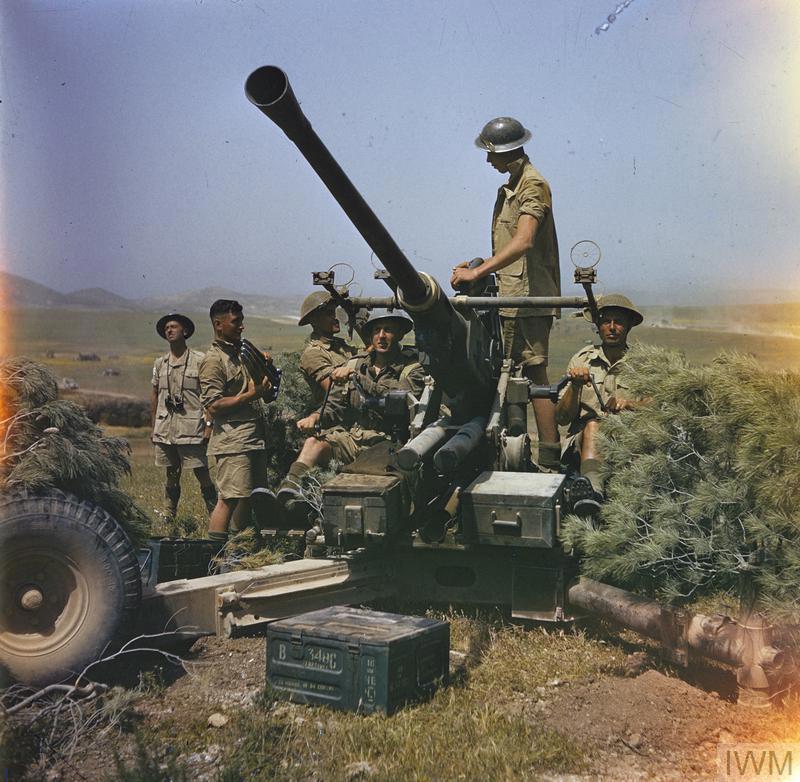
A British Bofors gun crew during the fighting in Tunisia (© IWM TR 940)
On April 22nd, at 8.00 pm, the falling dusk was rent apart by the fire of 400 British artillery guns. The barrage battered the hills as the infantry formed up.
The first attacks on Djebel Ahmera were repulsed by the German defenders. The attack’s commanding officer, Colin McNabb, was struck by shellfire and killed.
Leaping into action, Major John “Jock” Anderson took up the attack.
Under Anderson, the Argylls began climbing the hill, eliminating strong points along the way. Casualties were high, but by nightfall of the 23rd, the western half of Longstop Hill was in British hands.
The Argylls, reinforced by the Surreys, had taken Djebel Ahmera.
For his inspirational actions during the attack on Longstop, Major Anderson was awarded a Victoria Cross. His citation reads:
“Major Anderson re-organised the battalion, led the assault on the second objective, and, despite a leg wound, captured Longstop Hill with a total force of only four officers and less than forty other ranks. He personally led attacks on at least three enemy machine-gun positions and in every case was the first man in the enemy gun pits.”
On the eastern half of Longstop Hill, on the 26th of April, an attack was launched to capture Djebel Rhar.
Here, the infantry of the Buffs was accompanied by the rumbling advance of the North Irish Horse’s Churchill tanks.
The Churchills, though slow and heavy, could traverse the rocky terrain and steep slopes of the high ground, even clearing gradients as steep as 1:3.
Advancing up the slopes, the British infantry and tanks were able to traverse the summit, eliminating German strong points, and ultimately forcing the surrender of the Wehrmacht units atop the hill.
One German officer at Djebel Rhar said he knew it was “all over” when the tanks came roaring up the hill. Many Wehrmacht soldiers were in sheer disbelief that such seemingly cumbersome tanks could get up such steep gradients.
By the 26th, Longstop Hill was in British hands. The last natural barrier on the route to Tunis had been overcome.
The Capture of Tunis
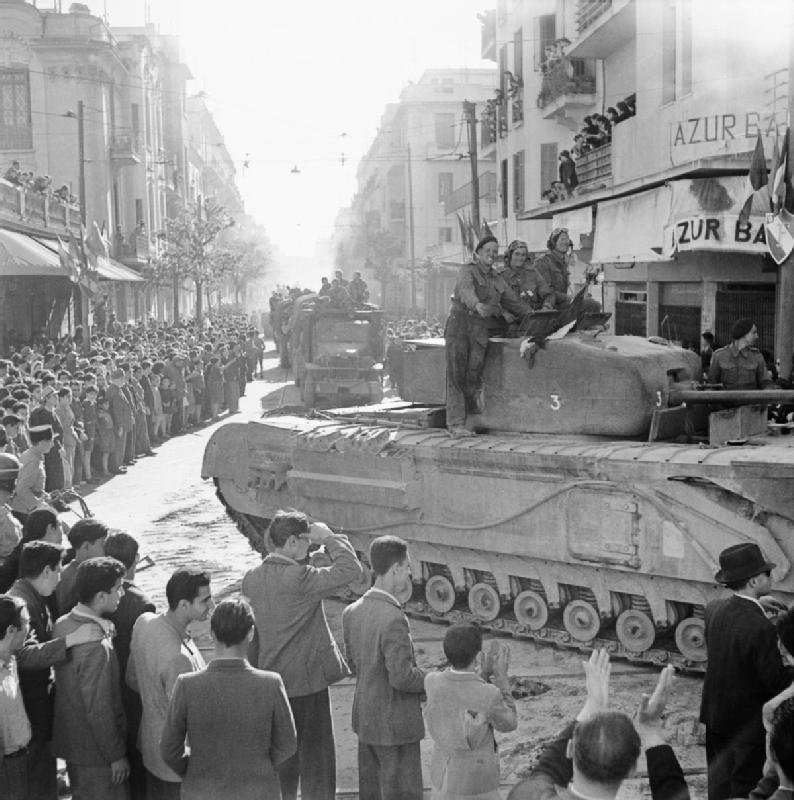
A British Churchill tank passes through the streets of Tunis following its capture (Wikimedia Commons)
The Allies had endured two years of setbacks, losing thousands of men, and tons of equipment, to reach this point. Now, the end of the North African campaign was in site.
Tunis was the glittering prize. With its capture, the Axis forces in North Africa would be forced to surrender.
Despite valiant and determined fighting since the end of December, the Wehrmacht and their Italian allies had been pushed back thousands of miles and finally kettled into the area around Tunisia’s capital.
One last effort was needed to end the North Africa campaign.
On the night of the 5th of May, the US 3rd Infantry Division captured a high ridge with clear views of the Mediterranean Sea near Tunis. They faced no resistance.
The fighting vehicles of the US 1st Armoured Division fired up their engines and began to advance along the road to Tunis in broad daylight.
Constant Allied pressure caused the Axis frontlines to crumble. The old Wehrmacht tactic of throwing heavy counterattacks at the Allies had failed to make gains. The Allies’ advance was relentless, breaking German and Italian resistance before it.
Such was the intensity that German commentators, including the Nazi’s chief propagandist Joseph Goebbels, dubbed The Battle of Tunis “Tunisgrad”.
By this time, the RAF had control of the skies across North Africa. Luftwaffe attacks were a distant memory.
Soon, the village of Massicault was captured with no resistance.
The Axis will to fight was melting away.
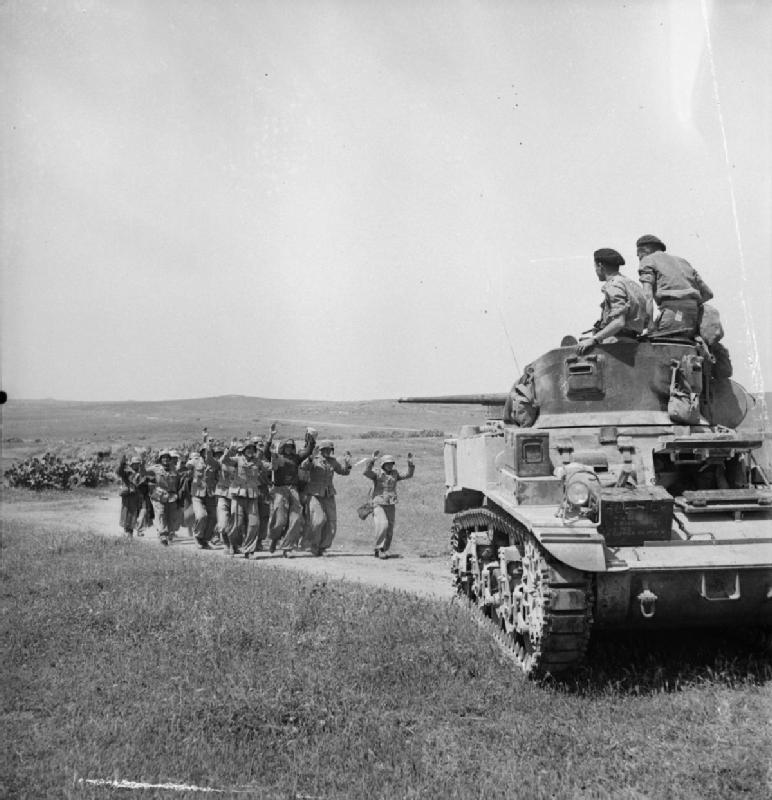
German troops surrender to a British M3 Stuart (Wikimedia Commons)
By the afternoon of the 6th, British infantry had captured their objectives, further opening the Tunis corridor.
The British 6th and Seventh Armoured Divisions swept forward and entered Tunis in triumph on May 7th, 1943.
The first British units to enter Tunis were the 11th Hussars and the Derbyshire Yeomanry.
While Tunisia signalled the death knell for Axis resistance in North Africa, there was still work to be done.
The British 7th Armoured Division swept north, supporting the US 1st Armoured, to face down a German tank force. The Wehrmacht armoured units surrendered without a fight.
On the 9th of May, German Commander General Gustav von Vaerst’s 5th Panzer Armee surrendered. 250 German tanks were captured.
The final pockets of Wehrmacht resistance were mopped up on the 12th of May 1943. A fierce hour-long bombardment of German positions along coastal roads north of Tunis forced the surrender of General Hans Graf von Sponeck. Von Sponeck and his entire division were taken prisoner.
By the 13th of May, the major fighting across North Africa had ceased. The Allies had tasted victory in North Africa.
For the British, it was one of the first major land campaign victories of the war.
Casualties of the North Africa campaign
Axis losses were heavy.
Together, the Italian and German forces in the theatre had lost over 40,000 men killed since June 1940. Up to 500,000 men had been taken prisoner.
Materially, the Axis had also lost some 2,500 tanks, 70,000 trucks and service vehicles, 6,200 artillery pieces, and 8,000 aircraft.
At the time, in May 1943, the only comparable loss for the Axis powers was Stalingrad in the East.
Victory, however, at come at a cost for the Allies. The US and Free French forces campaigning in the region lost over 34,000 service personnel, killed, captured, or missing.
The toll for the British Empire forces was higher.
At the Commonwealth War Graves Commission, we have over 43,000 casualties of the North African campaign in our care.
These men and women represent the scope of the former British Empire forces. As well as British troops, we commemorate those personnel from Australia, New Zealand, India, South Africa, and wider African regions, that died in North Africa.
Including killed, captured, wounded, or missing servicemen, total British and Commonwealth casualties stood at 220,000.
Chhelu Ram VC
 Image: a charcoal portrait of Chhelu Ram
Image: a charcoal portrait of Chhelu Ram
Many of the men fighting to clear the way towards Tunis achieved feats of heroism above and beyond the already incredible bravery soldiers show in combat.
One such man was Company Havildar-Major Chhelu Ram of the 4/6th Rajputana Rifles.
A Havildar is equivalent rank to a sergeant within the British army, making Ram a Sergeant-Major.
Ram and his unit were fighting against Axis forces in a craggy area of high ground called Djebel Garcia along the north approaches to Tunis during the closing stages of the North Africa campaign.
On the night of the 19th of April 1943, Ram and his men in the vanguard of the 5th Indian Infantry Brigade had their path impeded by a storm of machine-gun bullets and mortar fire.
Throwing caution to the wind, Ram let loose a rallying cry: “Jat aur Musalmano aage badho dhava bolo! [“Jats and Mohmmedans, there must be no withdrawal! We will advance! Advance!”]
Ram swept up his Thompson submachine gun, blitzed an enemy machine gun post, and ran to help his wounded company commander. His company followed soon after.
Ram was wounded but leapt forward into a melee of hand-to-hand combat. He was again wounded yet continued to rally his men onward before finally succumbing to his injuries.
For his gallantry and courage under fire, Chhelu Ram was posthumously awarded the Victoria Cross. He is buried at Sfax War Cemetery.
Charles Antony Lyell, 2nd Baron Lyell, VC
 Image: Charles Antony Lyell (Wikimedia Commons)
Image: Charles Antony Lyell (Wikimedia Commons)
Although he came from an aristocratic background, Charles Antony Lyell did not shirk from military service.
Indeed, his father had served in the First World War before contracting Spanish Flu and passing away in 1918. Serving in the armed forces was in Lyell’s blood.
Lyell was 29 years old and had been appointed temporary captain of the Scots Guards 1st Battalion when he was fighting in Tunisia.
The Scots Guards were engaged in fighting near the village of Bou Arada, some 90 kilometres from Tunis, on the 27th of April 1943 when Lyell led an attack on a German emplacement.
The German troops were well dug in, armed with machine guns and a fearsome Flak 88 anti-aircraft gun, occupying two separate pits.
Lyell rallied his men and charged the machine gun nest. The nest was cleared with a grenade and dived into the second pit. Lyell managed to kill several Wehrmacht soldiers before finally being overwhelmed by weight of numbers.
However, the machine guns and artillery piece were silenced, allowing the Scots Guards to continue their advance.
Lyell was posthumously awarded the Victoria Cross for his actions but he was not alone in the attack. He was supported by:
• Lance-Sergeant James Robertson
• Lance-Corporal James Ramage Kinghorn Lawrie
• Guardsman John Chisholm
• Guardsman William Porter
Lance-Corporal Lawrie and Guardsman Chisholm survived the attack and were each awarded the Military Medal. The others were unfortunately killed with Lance-Sergeant Robertson and Guardsman William Porter were mentioned in dispatches.
Today, Lyell is buried alongside his comrades in Massicault War Cemetery, Tunisia.
Cemeteries & Memorials in Tunisia
Casualties from the Battle of Tunis are likely to be buried or commemorated in the Commonwealth War Graves cemeteries and memorials in Tunisia.
However, we commemorate many casualties from the wider North African campaign at the CWGC; over 43,000 as mentioned above. Around 9,600 of these casualties are commemorated in Tunisia
Check out some of our most notable Tunisian sites below.
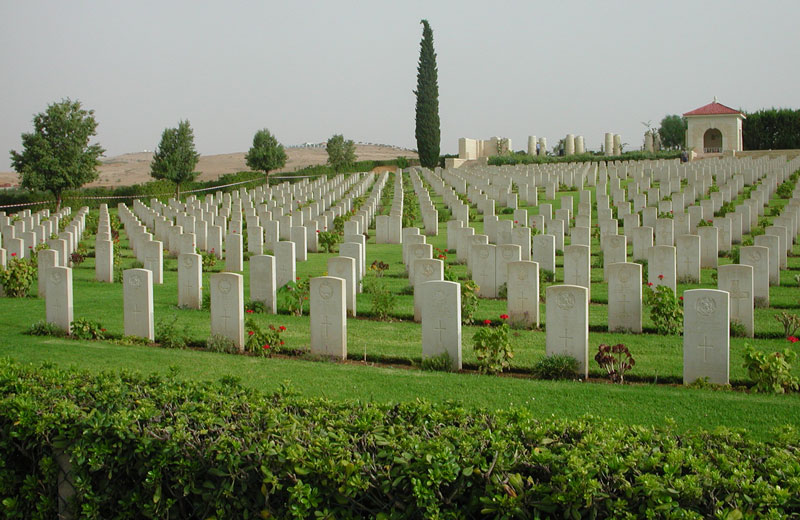
Massicault War Cemetery
Massicault lies around 30 kilometres southwest of Tunis.
The village itself lay directly in the path of the advancing Allies during the final push on Tunisia’s capital in May 1943. However, little resistance was offered and Massicault was captured without much of a fight.
Many of those buried at Massicault War Cemetery fell during the drive to Tunis in April and May 1943. 1,575 or so Commonwealth troops are buried there, 130 of which are unidentified.

Medjez-el-Bab War Cemetery
The path to Tunis was fraught with conflict and campaigning. Medjez-el-Beb was one important location on the route to the capital city and saw fierce fighting from late 1942 up to April 1943.
In fact, Medjez-el-Bab marked the limits of the Allied advance up until 1942. It remained the frontline until the breakthroughs of April and May of the following year.
Some 2,900 Commonwealth service personnel are commemorated at Medjez-el-Bab War Cemetery.
Around 380 of these casualties are unidentified.
Another 2,000 men are commemorated on the Medjez-el-Bab Memorial. The memorial is dedicated to those who fell in Tunisia between November 1942 and May 1943 but have no known grave.
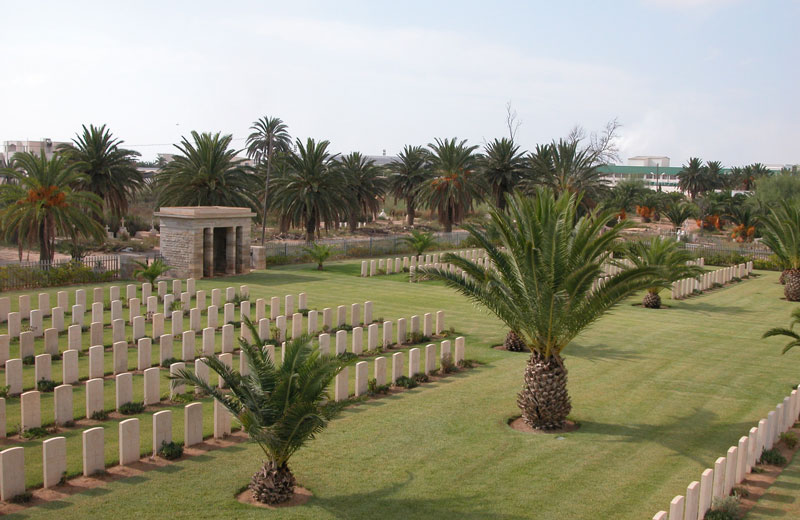
Sfax War Cemetery
While British, Free French and American forces were advancing into Tunisia from Algeria in the north, General Bernard Montgomery and 8th Army were pushing into the country via Libya in the south.
Sfax, a coastal city, today contains Sfax War Cemetery where just over 1,250 Commonwealth soldiers are commemorated.
The majority of these burials were casualties from Allied attacks on Axis positions at Medenine, the Marith Line, and Wadi Akarit in March and April 1943.
Learn more stories of the Fallen with Commonwealth War Graves
Our search tools can help you uncover more stories of those commemorated by the Commonwealth War Graves Commission.
Use our Find War Dead tool to search for specific casualties by name, where they served, which branch of the military they served in, and more parameters.
Looking for a specific location? Use our Find Cemeteries & Memorials search tool to find all our sites. You can search by country, locality, and conflict.

